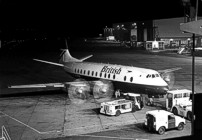
July 1973 to January 1984
British Airways (BA)
G-APIM - c/n 412 - a V.806 series Viscount
United Kingdom registered
31 July 1973
Transferred from Cambrian Airways due to a corporate merger.
12 November 1973
Rolled out in British Airways (BA) livery with small 'Cambrian' titles on the forward fuselage.
1 April 1974
Registered to British Airways (BA).
27 November 1974
Total time 27,961:23 hours and 27,411 total landings.
16 April 1975
Total time 28,343:27 hours and 28,027 total landings.
October 1976
Noted in British Airways (BA) livery with small 'Channel' titles on the forward fuselage.
12 September 1977
Total time 31,353:39 hours and 32,054 total landings.
7 December 1977
Ground-looped on landing at Kirkwall Airport, Orkney Islands, Scotland.
After a period of circling the airport due to bad weather the aircraft finally landed at Kirkwall Airport, Orkney Islands, Scotland from Dyce Airport, Aberdeen, Scotland on flight BZ762. When the crew tried to brake the aircraft aquaplaned, ground-looped and then skidded off the righthand side of the runway into soft ground. The starboard propellers dug into the soft ground and threw debris against the fuselage, which added to the already tense atmosphere amongst the passengers as the aircraft came to a sudden halt.
There was some damage to the aircraft, starboard propellers and engines but no injuries to the passengers or crew, although a lot of them were in a state of shock afterwards.
One of the passengers, Peter Gledhill, who was a field sales executive with Volvo Penta UK assisted the Chief Steward in the evacuation by volunteering to jump down from the starboard rear door in order to assist in holding down the escape shute, so that the passengers and then the cabin crew could safely evacuate the aircraft. The ground conditions were very muddy and windy at the time. Mr J R Ridgeway who was the district Superintendent for British Airways at Kirkwall sent a letter of praise to Volvo Penta UK, which then appeared in their 'house' newspaper in early 1978.
Repaired locally.

British Airways (BA)
'British' livery
11 May 1978
Total time 32,195:51 hours and 33,218 total landings.
18 November 1979
Total time 34,420:54 hours and 36,141 total landings.
14 November 1980
Rolled out at Rhoose Airport, Cardiff, South Glamorgan, Wales with British Airways (BA) 'British' titles.
24 February 1981
Total time 35,524:16 hours and 37,625 total landings.
16 December 1981
This was the last British Airways (BA) Viscount to be overhauled at the Rhoose Airport, Cardiff, South Glamorgan, Wales facility.
26 March 1982
Operated the last BA Viscount service to Birmingham International Airport, Elmdon, West Midlands, England from Dyce Airport, Aberdeen, Scotland.
The crew on board were Captain Robert (Bob) Parker, First Officer Brian Norton, Purser Hilary Mitchell and Stewardess Carol Shore.
27 and 28 March 1982
British Airways (BA) operated special flights from Abbotsinch Airport, Glasgow, Scotland to Kirkwall Airport, Orkney Islands, Scotland with Viscounts G-AOYL, G-AOYM, G-AOYO and G-APIM, to mark the airline's withdrawal of the type twenty-five years after it had first visited Kirkwall and following twenty years of scheduled services. Three hundred passengers, many of whom were British Airways (BA) air crew and ground crew, past and present, took part in the occasion, which included a celebratory dinner and dance at Kirkwall. The instigator and chief organiser of this very popular and fondly remembered event was Jack Ridgway, who was to serve for nearly twenty years as BEA - British European Airways and British Airways (BA) Station Manager at the airport. Hundreds of spectators watched as the four aircraft departed at lunchtime on Sunday 28 March, each making a low flypast of the airport and the town.
28 March 1982
Last service for British Airways (BA) from Kirkwall Airport, Orkney Islands to Abbotsinch Airport, Glasgow, Scotland.
The service was flown by Captain Robert (Bob) Parker with Purser Hilary Mitchell and Stewardess Carol Shore in the cabin. The First Officer's name is not known.
15 April 1982
Ferried to Rhoose Airport, Cardiff, South Glamorgan, Wales and withdrawn from service and stored.
This aircraft was the last Viscount to be retired from British Airways (BA) service.
18 January 1984
Taken out of storage and operated the service from Heathrow Airport, London, England to Jersey, Channel Islands instead of the BAC One-Eleven due to heavy snow stopping the jet from operating.
This happened on the following day as well, which must have been embarassing for BA as the BAC One-Eleven had replaced the Viscount.
20 January 1984
Ferried back to Rhoose Airport, Cardiff, South Glamorgan, Wales and finally withdrawn from BA service.
27 January 1984
Sold to British Air Ferries (BAF).
 FURTHER READING: Books about British Airways (BA) FURTHER READING: Books about British Airways (BA)
|



